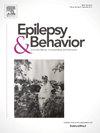Brain damage caused by status epilepticus: A prospective MRI study
IF 2.3
3区 医学
Q2 BEHAVIORAL SCIENCES
引用次数: 0
Abstract
Background
Status epilepticus (SE) is a severe neurological condition that might lead to long-term consequences such as neuronal death. This study investigated whether SE leads to brain volume loss by characterizing the dynamic of peri-ictal MRI abnormalities (PMA) through follow-up MRIs and assessing whether SE duration and specific outcome characteristics are associated with brain atrophy.
Methods
A prospective single-center cohort study enrolled 590 adult patients with definitive or possible SE. MRI in an acute setting was performed in 353/590 (60 %) patients. Follow-up MRIs at one week and one month were conducted to assess the reversibility of PMA. Measurements of diffuse brain volume were performed by employing a voxel-based morphometry with FreeSurfer, comparing an initial MRI with a follow-up test done four weeks after the initial one. The study analyzed the correlation between brain volume loss, SE duration, and clinical outcomes.
Results
PMA were observed in 156/353 (44 %) patients in at least one MRI sequence. In 44/83 (53 %) patients, PMA were reversible in one week. PMA persisted in 39/83 (47 %) patients. A second follow-up MRI was performed four weeks after the initial MRI in 33/39 (85 %) patients. In 14/33 (42 %), the MRI showed signs of focal atrophy, mostly in hippocampus. Volumetric analysis performed in patients who underwent two follow-up MRIs, indicated that 85 % of patients (28/33) had a decreased diffuse brain volume, with a median volume reduction of 16 %. A moderate negative correlation was found between diffuse brain volume and SE duration (Spearman correlation: −0.57) as well as hospitalization length (Spearman correlation: −0.60). This indicates that longer SE duration and extended hospitalization were associated with a greater brain volume loss.
Conclusion
In this prospective study, a proportion of patients displayed cerebral volume loss following a SE. These patients had longer duration and worse outcome of SE. However, the findings should be interpreted with caution due to several limitations, including the lack of consideration for underlying etiologies that may contribute to volume loss.
癫痫状态导致的脑损伤:前瞻性磁共振成像研究
背景癫痫(SE)是一种严重的神经系统疾病,可能导致神经元死亡等长期后果。本研究通过随访核磁共振成像(MRI)描述癫痫发作周围核磁共振成像异常(PMA)的动态特征,并评估癫痫持续时间和特定结果特征是否与脑萎缩相关,从而研究癫痫是否会导致脑容量损失。353/590(60%)例患者在急性期接受了磁共振成像检查。分别在一周和一个月后进行磁共振成像随访,以评估 PMA 的可逆性。通过使用 FreeSurfer 进行基于体素的形态测量来测量弥漫性脑容量,并将初次 MRI 与初次 MRI 四周后的随访测试进行比较。研究分析了脑容量损失、SE持续时间和临床结果之间的相关性。结果156/353(44%)名患者至少在一次磁共振成像序列中观察到PMA。44/83(53%)例患者的 PMA 在一周内可逆。39/83(47%)名患者的 PMA 持续存在。33/39(85%)名患者在首次 MRI 四周后进行了第二次 MRI 随访。14/33(42%)例患者的磁共振成像显示有局灶性萎缩的迹象,主要集中在海马区。对接受两次后续核磁共振成像检查的患者进行的体积分析表明,85% 的患者(28/33)的弥漫性脑体积缩小,体积缩小的中位数为 16%。弥漫性脑容量与 SE 持续时间(Spearman 相关性:-0.57)和住院时间(Spearman 相关性:-0.60)之间呈中度负相关。结论在这项前瞻性研究中,一部分患者在 SE 后出现脑容量损失。在这项前瞻性研究中,一部分患者在 SE 后出现脑容量损失,这些患者的 SE 持续时间较长,结果也较差。然而,由于存在一些局限性,包括没有考虑可能导致脑容量损失的潜在病因,因此在解释研究结果时应谨慎。
本文章由计算机程序翻译,如有差异,请以英文原文为准。
求助全文
约1分钟内获得全文
求助全文
来源期刊

Epilepsy & Behavior
医学-行为科学
CiteScore
5.40
自引率
15.40%
发文量
385
审稿时长
43 days
期刊介绍:
Epilepsy & Behavior is the fastest-growing international journal uniquely devoted to the rapid dissemination of the most current information available on the behavioral aspects of seizures and epilepsy.
Epilepsy & Behavior presents original peer-reviewed articles based on laboratory and clinical research. Topics are drawn from a variety of fields, including clinical neurology, neurosurgery, neuropsychiatry, neuropsychology, neurophysiology, neuropharmacology, and neuroimaging.
From September 2012 Epilepsy & Behavior stopped accepting Case Reports for publication in the journal. From this date authors who submit to Epilepsy & Behavior will be offered a transfer or asked to resubmit their Case Reports to its new sister journal, Epilepsy & Behavior Case Reports.
 求助内容:
求助内容: 应助结果提醒方式:
应助结果提醒方式:


